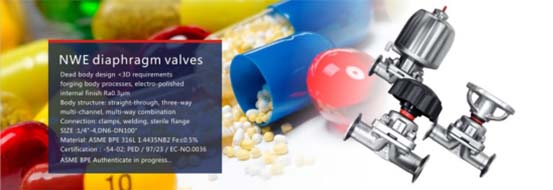 30 Fri 2025
30 Fri 2025
Sanitary diaphragm valves are widely used in industries with high hygiene requirements such as food, pharmaceuticals, beverages, and bioengineering. Their material selection and industry standards must meet the requirements of corrosion resistance, pollution-free, and easy cleaning. The following is the relevant content of its material selection and industry standards:
The material selection of sanitary diaphragm valves is crucial, which will affect their chemical compatibility, high temperature and pressure resistance, cleanliness, and overall service life. Key components and their typical materials include:

316L stainless steel: This is the most common and preferred material for sanitary valve bodies. Its characteristics include:
Corrosion resistance: Excellent resistance to a variety of chemicals (including acids, alkalis, and detergents).
316L stainless steel contains molybdenum elements, which are more corrosion-resistant. It is especially suitable for contact with corrosive media or environments with extremely high hygiene requirements, and meets GMP standards.
ASME BPE 316L: For material requirements, dimensional tolerances and polishing grades, there are higher requirements, and it is used in the pharmaceutical and bioengineering industries, so this material is selected. BPE standards require a smooth surface without cracks, dents or other defects to ensure the hygienic performance of the product.
Forged valve body vs. cast valve body:
* Different working principles:
Casting: Liquid metal is poured into a mold and cooled and solidified to form a casting.
Forging: The metal is heated and then hammered or extruded to form a shape.
* Different product performance:
Forged valve body: Higher density, lower porosity, and can achieve extremely low surface roughness (such as Ra 10 or Ra 15), which is ideal for ultra-high purity applications. Forged products have higher tensile strength and impact toughness.
Cast valve body: High cost-effective, but may have higher porosity. Although suitable for many hygienic applications, they may not achieve the same ultra-low surface roughness as forged valve bodies. Cast products have lower tensile strength and impact toughness and are suitable for medium and low pressures.
The diaphragm is the most critical component because it is in direct contact with the process media and provides a sterile barrier. The material selection is flexible, chemically resistant, and FDA compliant.
EPDM:
Advantages: Excellent flexibility, good resistance to steam (suitable for SIP), hot water, and a variety of polar chemicals. High cost-effectiveness, more suitable for vacuum environments.
Disadvantages: Limited resistance to grease and some non-polar solvents.
EPDM+PTFE:
Available in both bonded and separated options. Containing all the advantages of EPDM and PTFE, this material is recommended as the first choice.
Advantages: High chemical resistance, extremely high stability, good elasticity, long life, high sealing, no cold deformation, and excellent performance that is not affected by temperature fluctuations, whether it is hot or cold cycles, or steam sterilization systems. The separated type has a better service life than the bonded type and can withstand higher temperatures and harsh working conditions.
Disadvantages: Low cost-effectiveness.
Silicone:
Advantages: Good flexibility, high temperature resistance of 150°C, commonly used in food and beverage applications.
Disadvantages: Poor chemical resistance and low mechanical strength compared to PTFE.
Fluororubber (FKM/FPM):
Advantages: Excellent resistance to high temperatures, oils, fuels and a variety of chemicals, with a maximum temperature resistance of 180 degrees Celsius.
Disadvantages: Low cost-effectiveness, not very suitable for steam sterilization systems.
1. Surface finish (internal polishing):
Measured in Ra (average roughness), the lower the Ra value, the cleaner the surface.
General sanitary requirements: 0.4 µm (15 Ra µin).
Sterile/high purity: Usually a lower Ra value is required, such as 0.25 µm (10 Ra µin), and electrolytic polishing is required to obtain a smoother, passivated and corrosion-resistant surface.
2. ASME BPE Standard:
This is the most comprehensive and recognized standard for equipment design, materials, manufacturing, inspection and testing in the biopharmaceutical industry.
3. Hygiene standards:
For example, the EU's EC 1935/2004 regulation stipulates the safety requirements for materials and products in contact with food. The material and surface treatment of sanitary diaphragm valves must comply with this regulation to prevent food contamination.
4. Pressure and temperature standards:
Standards such as GB/T 12241-2005 "General Requirements for Safety Valves" stipulate the pressure level and applicable temperature range of valves to ensure that diaphragm valves can work normally under different working conditions, such as maintaining good mechanical properties and sealing properties at high temperatures; under high pressure, the material must have sufficient strength and toughness to withstand high pressure without deformation or damage.
5. Certification standards
Different industries have specific regulations and standard requirements for the materials of sanitary valves. For example, the food industry must follow the US 3A standard and the EU EHEDG standard; the pharmaceutical industry must meet GMP requirements. The selected materials must meet these regulations and standards to ensure the legal use of valves in the corresponding industries.
1. Corrosive media: 316L valve body and EPDM + PTFE diaphragm are preferred.
2. High temperature sterilization (SIP)/online cleaning CIP: EPDM + PTFE diaphragm
3. Cost sensitive: 316L stainless steel + EPDM diaphragm (suitable for non-extreme environments), cast valve body.
4. Aseptic requirements: select zero dead angle design, electrolytic polishing valve body, preferably ASME BPE SS316L.
5. Pharmaceutical and biopharmaceutical industries: ASME BPE SS316L is preferred
Diaphragm assemble video
DONJOY diaphragm valve is designed according to ASME BPE standards and is certified by 3A and CE.
Why sanitary stainless steel butterfly valves corrosion resistant?